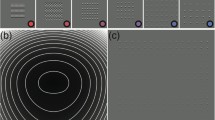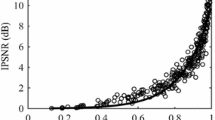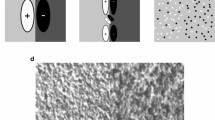Abstract
Texture-discrimination algorithms have often been tested on images containing either mosaics of synthetic textures or artificially created mosaics of real textures — in any case, images in which most of the changes in intensity can be ascribed to the textures themselves. However, real images are not formed like this and may contain steep gradations in intensity which have nothing to do with local texture, such as those caused by incident shadows. A texture discrimination algorithm based on linear filters can fail in the presence of these strong gradations, as they may easily contain an order of magnitude more energy than the gradations in intensity due to texture in the image per se. In these cases, the mechanism may become responsive only to strong luminance effects, and not to texture. I have found that good performance on natural images containing texture can only be obtained from a filter-based texture detection scheme if it includes a stage which attempts to bring large intensity gradients within bounds. The exact nature of the best precompensator appears to depend somewhat on the way the filter outputs are processed. The fit to psychophysical data and the implications for more detailed models of human texture processing will be discussed.
Similar content being viewed by others
References
Bovik AC, Clark M, Geisler WS (1990) Multichannel texture analysis using localized spatial filters. IEEE Trans Pattern Anal Mach Intell 12:56
Canny J (1983) Finding edges and lines in images. MIT AI Lab Tech Rep 720
Cavanagh P (1987) Reconstructing the third dimension — interactions between color, texture, motion, binocular disparity and shape. Comput Vision Graphics Image Process 37:171
Gamble E, Poggio T (1987) Visual integration and detection of discontinuities: the key role of intensity edges. MIT AI Lab Memo 970
Geiger D, Girosi F (1989) Parallel and deterministic algorithms for MRFs: surface reconstruction and integration. MIT AI Lab Memo 1114
Geman S, Geman D (1984) Stochastic relaxation, Gibbs distributions, and the Bayesian restoration of images. IEEE Trans Pattern Anal Mach Intell 6:721
Grossberg S, Mingolla E (1985) Neural dynamics of perceptual grouping: textures, boundaries, and emergent segmentations. Percept Psychophys 38:141
Gurnsey R, Browse R (1987) Micropattern properties and presentation conditions influencing visual texture discrimination. Percept Psychophys 41:239
Heeger D (1989) Computational model of cat striate physiology. MIT Media Lab Tech Rep 125
Hurlbert A, Poggio T (1987) Learning a color algorithm from examples. MIT AI Lab Memo 909
Hurlbert A, Poggio T (1988) Synthesizing a color algorithm from examples. Science 239:482
Julesz B (1981a) Textons, the elements of texture perception and their interactions. Nature 290:91
Julesz B (1981b) A theory of preattentive texture discrimination based on first-order statistics of textons. Biol Cybern 41:131
Julesz B (1986) Texton gradients: the texton theory revisited. Biol Cybern 54:245
Julesz B, Bergen JR (1983) Textons, the fundamental elements in preattentive vision and perception of textures. Bell System Tech J 62:119
Kröse B (1987) Local structure analyzers as determinants of preattentive pattern discrimination. Biol Cybern 55:289
Land E (1964) The retinex. Am Sci 52:247
Land E (1986) An alternative technique for the computation of the designator in the retinex theory of color vision. Proc Natl Acad Sci USA 83:3078
Malik J, Perona P (1989) A computational model of texture perception. UC Berkeley Tech Rep UCB/CSD 89/491
Malik J, Perona P (1990) Preattentive texture discrimination with early vision mechanisms. J Opt Soc Am [A] 7:923
Poggio T, Little J, Gamble E, Gillett W, Geiger D, Weinshall D, Villalba M, Larson N, Cass T, Bülthoff H, Drumheller M, Oppenheimer P, Yang W, Hurlbert A, Beymer D, O'Donnell P (1990) The MIT vision machine. In: Winston PH (eds) Artificial intelligence at MIT: expanding frontiers. MIT Press, Cambridge, Mass., pp 492–529
Riley M (1981) The representation of image texture. MIT AI Lab Tech Rep 649
Reed TR, Wechsler H (1990) Segmentation of textured images and gestalt organization using spatial/spatial-frequency representations. IEEE Trans Pattern Anal Mach Intell 12:1
Turner M (1986) Texture discrimination by Gabor functions. Biol Cybern 55:71
VanGool L, Dewaele P, Oosterlinck A (1983) Texture analysis anno 1983. Comput Vision Graphics Image Process 29:336
Voorhees H (1987) Finding texture boundaries in images. MIT AI Lab Tech Rep 986
Voorhees H, Poggio T (1988) Computing texture boundaries from images. Nature 333:364–367
Author information
Authors and Affiliations
Rights and permissions
About this article
Cite this article
Thau, R.S. Illuminant precompensation for texture discrimination using filters. Biol. Cybern. 71, 239–250 (1994). https://doi.org/10.1007/BF00202763
Received:
Accepted:
Issue Date:
DOI: https://doi.org/10.1007/BF00202763




